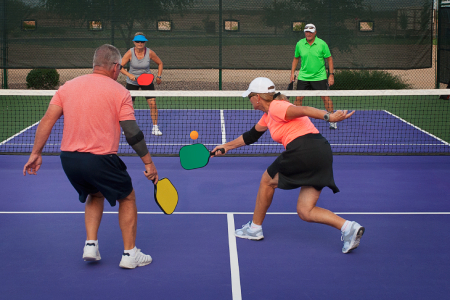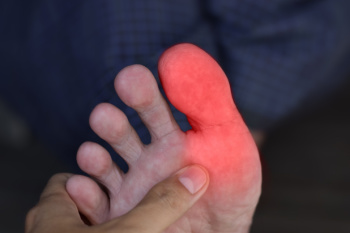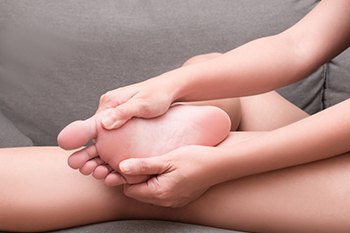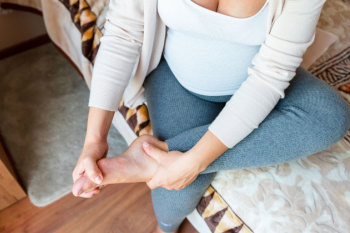Connect With Us
Blog
Items filtered by date: August 2025
Common Injuries From Playing Pickleball

Pickleball can place significant strain on the feet and ankles due to the frequent pivoting, jumping, and quick side-to-side movements involved in the game. Ankle sprains are a common pickleball injury, occurring when the foot rolls awkwardly and stretches or tears the ligaments. Repeated strain from quick movements can also lead to Achilles tendonitis, which causes pain and stiffness in the tendon that connects the heel to the calf. Heel pain from plantar fasciitis is another frequent problem, often linked to playing on hard surfaces or wearing shoes that lack adequate support. A podiatrist can help by identifying the specific cause of foot or ankle pain and providing the necessary treatment to promote healing and reduce the risk of further injury. If you have a foot or ankle injury from playing pickleball, it is suggested that you schedule an appointment with a podiatrist for an exam and appropriate treatment options.
Sports related foot and ankle injuries require proper treatment before players can go back to their regular routines. For more information, contact Landon Bowerbank, DPM of Pioneer Foot and Ankle. our doctor can provide the care you need to keep you pain-free and on your feet.
Sports Related Foot and Ankle Injuries
Foot and ankle injuries are a common occurrence when it comes to athletes of any sport. While many athletes dismiss the initial aches and pains, the truth is that ignoring potential foot and ankle injuries can lead to serious problems. As athletes continue to place pressure and strain the area further, a mild injury can turn into something as serious as a rupture and may lead to a permanent disability. There are many factors that contribute to sports related foot and ankle injuries, which include failure to warm up properly, not providing support or wearing bad footwear. Common injuries and conditions athletes face, including:
- Plantar Fasciitis
- Achilles Tendinitis
- Achilles Tendon Rupture
- Ankle Sprains
Sports related injuries are commonly treated using the RICE method. This includes rest, applying ice to the injured area, compression and elevating the ankle. More serious sprains and injuries may require surgery, which could include arthroscopic and reconstructive surgery. Rehabilitation and therapy may also be required in order to get any recovering athlete to become fully functional again. Any unusual aches and pains an athlete sustains must be evaluated by a licensed, reputable medical professional.
If you have any questions please contact our office located in Lehi, UT . We offer the newest diagnostic and treatment technologies for all your foot and ankle needs.
Causes of Pain in the Big Toe

Discomfort in the big toe can stem from a range of issues, some developing gradually and others appearing suddenly. Arthritis, particularly in the joint at the base of the toe, can cause stiffness, swelling, and aching. Bunions may create pain by shifting the toe’s position and increasing pressure against footwear. Injuries such as sprains, fractures, or turf toe can result in immediate pain and swelling. Gout, a form of inflammatory arthritis, often brings intense and sudden pain along with redness and warmth in the joint. Even ingrown toenails can lead to tenderness and difficulty wearing shoes. Identifying the underlying cause is vital to finding the right treatment and preventing further complications. If you notice persistent pain, swelling, or changes in your big toe, it is suggested you seek care from a podiatrist for an accurate diagnosis and appropriate treatment solutions.
Toe pain can disrupt your daily activities. If you have any concerns, contact Landon Bowerbank, DPM of Pioneer Foot and Ankle. our doctor can provide the care you need to keep you pain-free and on your feet.
What Causes Toe Pain?
Most severe toe pain is caused due to a sports injury, trauma from dropping something heavy on the toe, or bumping into something rigid. Other problems can develop over time for various reasons.
Toe pain can be caused by one or more ailments. The most common include:
- Trauma
- Sports injury
- Wearing shoes that are too tight
- Arthritis
- Gout
- Corns and calluses
- Hammertoe
- Bunions
- Blisters
- Ingrown toenails
- Sprains
- Fractures (broken bones)
- Dislocations
When to See a Podiatrist
- Severe pain
- Persistent pain that lasts more than a week
- Signs of infection
- Continued swelling
- Pain that prevents walking
Diagnosis
In many cases the cause of toe pain is obvious, but in others, a podiatrist may want to use more advanced methods to determine the problem. These can range from simple visual inspections and sensation tests to X-rays and MRI scans. Prior medical history, family medical history, and any recent physical traumatic events will all be taken into consideration for a proper diagnosis.
Treatment
Treatments for toe pain and injuries vary and may include shoe inserts, padding, taping, medicines, injections, and in some cases, surgery. If you believe that you have broken a toe, please see a podiatrist as soon as possible.
If you have any questions please contact our office located in Lehi, UT . We offer the newest diagnostic and treatment technologies for all your foot and ankle needs.
Do Your Child's Feet Hurt?
Understanding Sesamoiditis

Sesamoiditis is an inflammation of the small bones located beneath the big toe joint. These bones help with balance and movement, but can become irritated from repetitive pressure, high-impact activities, or wearing shoes that lack proper cushioning. Dancers, runners, and athletes who frequently push off from the ball of the foot are more prone to developing this condition. Symptoms may include localized pain, swelling, and tenderness that worsens during activity. Resting the foot and wearing supportive footwear with cushioned insoles can help relieve discomfort. In some cases, activity modification and targeted stretches are recommended to prevent recurrence. Paying attention to early signs can help you avoid more serious injury and prolonged healing time. If foot pain interferes with daily movement, it is suggested that you consult a podiatrist for proper evaluation and appropriate treatment.
Sesamoiditis is an unpleasant foot condition characterized by pain in the balls of the feet. If you think you’re struggling with sesamoiditis, contact Landon Bowerbank, DPM of Pioneer Foot and Ankle. our doctor will treat your condition thoroughly and effectively.
Sesamoiditis
Sesamoiditis is a condition of the foot that affects the ball of the foot. It is more common in younger people than it is in older people. It can also occur with people who have begun a new exercise program, since their bodies are adjusting to the new physical regimen. Pain may also be caused by the inflammation of tendons surrounding the bones. It is important to seek treatment in its early stages because if you ignore the pain, this condition can lead to more serious problems such as severe irritation and bone fractures.
Causes of Sesamoiditis
- Sudden increase in activity
- Increase in physically strenuous movement without a proper warm up or build up
- Foot structure: those who have smaller, bonier feet or those with a high arch may be more susceptible
Treatment for sesamoiditis is non-invasive and simple. Doctors may recommend a strict rest period where the patient forgoes most physical activity. This will help give the patient time to heal their feet through limited activity. For serious cases, it is best to speak with your doctor to determine a treatment option that will help your specific needs.
If you have any questions, please feel free to contact our office located in Lehi, UT . We offer the newest diagnostic and treatment technologies for all your foot care needs.
How Pregnancy Affects Your Feet

During pregnancy, many women notice their feet feeling larger or wider. This change is often due to hormonal shifts that relax ligaments, causing the arches to flatten and feet to spread. In addition, weight gain and fluid retention can lead to swelling, discomfort, and balance changes. Common foot conditions during pregnancy include flat feet, overpronation, and heel pain. Some women may also develop varicose veins or experience leg cramps and aching feet. A podiatrist can provide supportive care through custom orthotics, footwear advice, and treatment for pain or swelling. If you are pregnant and experiencing foot changes or discomfort, it is suggested that you visit a podiatrist who can offer effective relief and treatment tips.
Pregnant women with swollen feet can be treated with a variety of different methods that are readily available. For more information about other cures for swollen feet during pregnancy, consult with Landon Bowerbank, DPM from Pioneer Foot and Ankle. our doctor will attend to all of your foot and ankle needs.
What Foot Problems Can Arise During Pregnancy?
One problem that can occur is overpronation, which occurs when the arch of the foot flattens and tends to roll inward. This can cause pain and discomfort in your heels while you’re walking or even just standing up, trying to support your baby.
Another problem is edema, or swelling in the extremities. This often affects the feet during pregnancy but tends to occur in the later stages.
How Can I Keep My Feet Healthy During Pregnancy?
- Wearing orthotics can provide extra support for the feet and help distribute weight evenly
- Minimize the amount of time spent walking barefoot
- Wear shoes with good arch support
- Wear shoes that allow for good circulation to the feet
- Elevate feet if you experience swelling
- Massage your feet
- Get regular, light exercise, such as walking, to promote blood circulation to the feet
If you have any questions, please feel free to contact our office located in Lehi, UT . We offer the newest diagnostic and treatment technologies for all your foot care needs.





